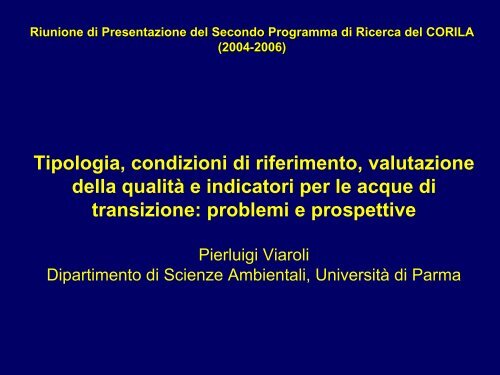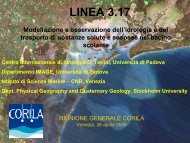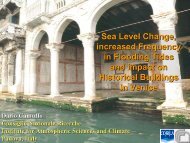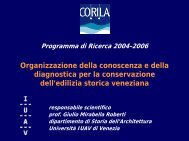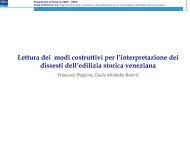GORO - Corila
GORO - Corila
GORO - Corila
You also want an ePaper? Increase the reach of your titles
YUMPU automatically turns print PDFs into web optimized ePapers that Google loves.
Riunione di Presentazione del Secondo Programma di Ricerca del CORILA CORILA<br />
(2004-2006)<br />
(2004 2006)<br />
Tipologia, condizioni di riferimento, valutazione<br />
della qualità e indicatori per le acque di<br />
transizione: problemi e prospettive<br />
Pierluigi Viaroli<br />
Dipartimento di Scienze Ambientali, Università di Parma
TIPOLOGIA<br />
Corpi idrici superficiali in prossimità della foce di un fiume, che sono<br />
parzialmente di natura salina a causa della loro vicinanza alle acque<br />
costiere, ma sostanzialmente influenzati dai flussi di acqua dolce<br />
(direttiva 2000/60/CE)<br />
Monitoraggio, valutazione ed azioni devono essere riferiti ai corpi idrici<br />
Commenti rilevanti in:<br />
Tagliapietra & Volpi Ghirardini, 2006. Notes on coastal lagoon typology in the<br />
light of the EU Water Framework Directive: Italy as a case study. Aquatic<br />
Conservation, Marine And Freshwater Ecosystems 16<br />
McLusky & Elliott, 2007. Transitional waters: A new approach, semantics or just<br />
muddying the waters? Estuarine, Coastal and Shelf Science 71: 359-363
McLusky & Elliott, 2007
TIPOLOGIA<br />
ICRAM<br />
Morfologia x Regime tidale x Dimensione x Salinità<br />
Tagliapietra et al.<br />
Zone lagunari = corpo idrico di riferimento<br />
Approccio scalare con parametri mesologici
Per ciascun tipo di corpo idrico sono fissati<br />
-elementi di qualità idro-morfologici, fisico-chimici e biologici<br />
-condizioni di riferimento per la definizione dello stato ecologico<br />
Non necessariamente indisturbato<br />
Stato ecologico elevato<br />
Riferimento temporale non vincolante<br />
- importanza degli indicatori<br />
Attinenza e capacità di risposta<br />
Sensibilità e range di sensibilità<br />
Variabilità e confidenza<br />
Le linee 3.11 e 3.12 danno risposte adeguate su tutti i punti rilevanti<br />
della WFD e aprono alcune interessanti prospettive su<br />
- tipologia, scale e unità di riferimento per il monitoraggio<br />
- valutazione dell’inquinamneto chimico ed ecotossicologia<br />
- bioindicazione a diversi livelli dell’organizzazione dei sistemi bio-ecologici<br />
- rapporto tra etero e autotrofia a livello del microbial loop
uncontaminated<br />
macroalgal blooms<br />
Quali condizioni di<br />
riferimento?<br />
Il quadro di un’evoluzione<br />
accelerata, dal 1970 ad oggi<br />
dystrophic crisis<br />
?
Conceptual representation of the succession of aquatic vegetation along an<br />
increasing eutrophication gradient according to 1: Nienhuis (1992), 2: Valiela et<br />
al. (1997) and Dahlgreen and Kautsky (2004); 3: Schramm (1999)<br />
Succession phases and conditions (pristine → altered)<br />
phanerogams phanerogams+epiphytes macroalgae+phytoplankton 1<br />
perennial benthic<br />
macrophytes<br />
seagrasses macroalgae phytoplankton 2, 3<br />
macrophytes+ fast<br />
growing epiphytes<br />
free floating<br />
macroalgae+phytoplankton<br />
Ref<br />
phytoplankton 4
Sistemi poco profondi in cui prevale la componente bentonica. Il<br />
metabolismo e le proprità dell’ecosistema dipendono dalla successione<br />
delle comunità vegetali<br />
Perturbation intensity (a.u.) relative abundance (a.u.) →<br />
←Pristine conditions Altered conditions →<br />
SG<br />
EP<br />
PHY<br />
P<br />
S/O<br />
MA<br />
Pico<br />
cyanobacteria N<br />
PI/CY<br />
Increasing eutrophication →
Thresholds of regions of stability of the main components in the primary<br />
producer community. SPM: suspended particulate matter. * in carbonate<br />
rich (iron poor sediments) # in iron rich (carbonate poor sediments). Data<br />
from (1) Valiela et al. (1997), (1) Dahlgreen and Kautsky (2004), (2)<br />
Calleja et al. (2005).<br />
DIN loading (1)<br />
(g m -2 y -1 )<br />
Region of stability<br />
DS in porewater (2)<br />
(µM)<br />
Phanerogams < 10 < 10* ÷ < 1000 #<br />
Macroalgae 10-50 no effect<br />
Phytoplankton > 50 no effect
Dahlgren & Kautsky, 2004
Recent evolution of benthic communities in selected coastal lagoons. (1) Piccoli et al., 1991; (2), Viaroli et al. 2006), (3) Sfriso<br />
and Facca (2007); (4) Bombelli and Lenzi (1996); (5) Giusti and Marsili-Libelli (2005); (6) Viaroli et al. (1999), (7) Andreoli et al.<br />
(1998) ; (8) Piccoli (1998) ; (9) Menedez et al. (2002) ; (10) Castel et al. (1996) ; (11) Souchu et al. (2000) ; (12) Orfandis et al.<br />
(2001) ; (13) Reizopoulou (pers. Com.) ; (14) Reizopoulou and Nicolaidou (2004) ; (15) Bogdanos and Diapoulis (1984) ; (16)<br />
Valiela et al. (1997).<br />
Pristine<br />
conditions<br />
Sacca di Goro (Italy) R. cirrhosa, Z. noltii Ulva and Gracilaria<br />
blooms<br />
Venice lagoon, central basin<br />
(Italy)<br />
1975-1995 present Ref.<br />
Moderate growth of<br />
Ulva and Gracilaria<br />
Z. noltii, C. nodosa Ulva blooms phytoplankton 3<br />
Orbetello lagoon (Italy) R. cirrhosa Ulva and Gracilaria<br />
blooms<br />
1, 2<br />
Gracilaria blooms 4, 5<br />
S’Ena Arrubia lagoon (Italy) R. cirrhosa Ulva and Gracilaria Filamentous<br />
macrolagae and MPB<br />
Valli di Comacchio (Italy) R. cirrhosa, L.<br />
papulosum<br />
Encanissada/Tancada (Spain) R. cirrhosa,<br />
Potamogeton crispus<br />
Filamentous macrolage<br />
blooms<br />
Moderate growth of<br />
Chaetomorpha linum<br />
Nanoplankton,<br />
cyanobacteria<br />
Patchy R. cirrhosa, C.<br />
limum and P. crispus<br />
Etang du Prévost (France) Z. noltii, R. cirrhosa Ulva blooms Ulva blooms 6, 10, 11<br />
Nestos lagoons, several basins<br />
(Greece)<br />
Tsopeli, Amvrakikos lagoons<br />
(Greece)<br />
R. cirrhosa n.a. R. cirrhosa, Ulva,<br />
Gracilaria and<br />
Cyanobacteria<br />
Zostera noltii n.a. Ulva blooms, Zostera<br />
noltii<br />
Papas lagoon (Greece) Cymodocea nodosa n.a. Ulva, Gracilaria blooms 14<br />
Aetoliko (Greece) Cymodocea nodosa Ulva and Cladophora n.a. 15<br />
Waquoit bay (U.S.) Zostera sp Cladophora, Gracilaria 16<br />
4, 6<br />
7,8<br />
9<br />
12<br />
13
Main community and biogeochemical features of the different<br />
alternative stable states determined by shifts in primary<br />
producer communities<br />
Seagrass<br />
meadow<br />
Macroalgae<br />
(bloom forming)<br />
Phytoplankton<br />
Microphytobenthos<br />
Biomass bulk High/persistent High/ephemeral Low/transient<br />
Growth rate Low High/very High High<br />
Biomass degradability Refractory Labile Labile/refractory<br />
Oxygen Balanced Unbalanced/dystrophy Variable<br />
Sulphide Absent to low High Absent to low<br />
Nitrogen<br />
Retention<br />
Low concentration<br />
Pulsing; Low to high<br />
concentrations<br />
variable<br />
Information (β value) High Low Very low
Possibili indicatori e/o<br />
descrittori biogeochimici<br />
-Acqua<br />
-Sedimento<br />
-Metabolismo
Indicatore semplice derivato dal Water Quality Index –<br />
Lagoon Water Quality Index (LWQI)<br />
Saturazione O 2, DIN, DIP, Ch-a<br />
Q-value<br />
100<br />
90<br />
80<br />
70<br />
60<br />
50<br />
40<br />
30<br />
20<br />
10<br />
0<br />
Dissolved Oxyen<br />
0 20 40 60 80 100 120 140 160 180 200 220 240<br />
%S AT<br />
fanerogame<br />
macroalghe<br />
Utilizzo di funzioni di utilità e di pesi attribuiti con parere esperto
80<br />
70<br />
60<br />
50<br />
40<br />
30<br />
20<br />
10<br />
0<br />
LM1<br />
LM2<br />
LM3<br />
LM4<br />
LL1<br />
Lagoon water quality index<br />
(Q-pesati)<br />
LL2<br />
LL3<br />
LL4<br />
GM1<br />
GM2<br />
L = Lesina ; G = Goro;<br />
M = maggio, L = luglio, A = agosto<br />
1, 2, 3, 4 = stazione<br />
GM3<br />
GM4<br />
GA1<br />
GA2<br />
GA3<br />
GA4<br />
DIP<br />
DIN<br />
rooted<br />
macroalghe<br />
chla<br />
DO
100<br />
90<br />
80<br />
70<br />
60<br />
50<br />
40<br />
30<br />
20<br />
10<br />
0<br />
Applicazione del L-WQI nelle 5 lagune del progetto<br />
DITTY<br />
Ria<br />
Formosa<br />
Mar menor Etang du<br />
thau<br />
Sacca di<br />
Goro<br />
Gera<br />
DIN<br />
SRP<br />
root cov<br />
Mac cov<br />
Chl-a<br />
O2 %
descrittori biogeochimici legati a produzione primaria<br />
e attività microbica<br />
O 2 produzione/respirazione disponibilità O 2 vie ossidative<br />
O 2 deficit solfuri reazioni solfuro-ferro FeS, FeS 2<br />
Interazioni ferro-solfuri-fosfati<br />
Ammonificazione/nitrificazione/denitrificazione perdita di N<br />
R-NH 2 NH 4 + NO3 - N2<br />
Reazioni e processi contribuiscono al metabolismo<br />
dell’ecosistema<br />
Net Ecosystem Metabolism (NEM)<br />
Buffering functions (BUF)
.<br />
Classification of ecosystem metabolism . based on oxygen<br />
production (NP = net production at light saturation) and<br />
consumption (DR = dark respiration). BP = biomass peak (L: low,<br />
H:High), BD = biodegradability (R: refractory, La: labile) C= NP<br />
and DR peaks are coincident, S= DR peak follows the NP peak<br />
(Rizzo et al., Estuaries, 1996; Viaroli & Christian, Ecological Indicators, 2003)<br />
===============================================================<br />
CATEGORIES CONDITION SYSTEM QUALIFICATIONS<br />
Rates BP/BD Timing<br />
-------------------------------------------------------------------------------------------------------------<br />
Dystrophy DR=NP
Dark Respiration Rates<br />
-25<br />
-50<br />
-25<br />
0<br />
0<br />
PU2<br />
Units: mmol m -2 h -1<br />
Maximun Net Production Rates<br />
0<br />
25<br />
macroalgae<br />
AU2<br />
50<br />
75<br />
bare sediment<br />
seagrass<br />
GU1<br />
1 2 3<br />
The extent of oxygen production and consumption reveals a<br />
symptom of disturbance within the ecosystem. A large excess of<br />
oxygen production is associated to the retention of a large amount<br />
of organic matter<br />
100
Dark Respiration (mmol m -2 h -1 )<br />
Dark Respiration (mmol m -2 h -1 )<br />
-10<br />
-12<br />
-14<br />
Net Oxygen Production (mmol m -2 h -1 )<br />
-20 -10 0 10 20 30<br />
0<br />
-2<br />
-4<br />
-6<br />
-8<br />
0<br />
-2<br />
-4<br />
-6<br />
-8<br />
-10<br />
-12<br />
-14<br />
Lesina<br />
<strong>GORO</strong><br />
1 Primavera<br />
2 Primavera<br />
3 Primavera<br />
4 Primavera<br />
1 Estate<br />
2 Estate<br />
3 Estate<br />
4 Estate<br />
Le stazioni di Lesina sono<br />
tendenzialmente<br />
autotrofiche (importanza<br />
fanerogame?)<br />
Le stazioni di Goro sono<br />
tendenzialmente<br />
eterotrofiche (importanza<br />
vongole?)
Il quoziente respiratorio (flusso CO 2 /flusso O 2 ) come<br />
indicatore della tendenza evolutiva del metabolismo<br />
dell’ecosistema a scala stagionale<br />
Estate<br />
3<br />
2<br />
1<br />
0<br />
0 1 2 3<br />
Primavera<br />
Lesina 1<br />
Lesina 2<br />
Lesina 3<br />
Lesina 4<br />
Goro 1<br />
Goro 2<br />
Goro 3<br />
Goro 4<br />
Goro 5<br />
Goro 6<br />
Orbetello A<br />
Orbetello B<br />
Orbetello C<br />
Orbetello D
Quoziente respiratorio<br />
3,5<br />
3,0<br />
2,5<br />
2,0<br />
1,5<br />
1,0<br />
0,5<br />
0,0<br />
Primavera<br />
Estate<br />
L1 L2 L3 L4 G1 G2 G3 G4 G5 G6 A B C D
La transizione ossico anossica altera gli equilibri sedimentari e<br />
favorisce il rilascio di solfuri il rilascio dei solfuri è controllato<br />
dalla disponibilità di ferro reattivo labile<br />
La predisposione del sedimento a<br />
trattenere/rilasciare solfuri può essere<br />
determinata mediante titolazione di<br />
un’aliquota di sedimento con del<br />
solfuro libero<br />
100ml di slurry di sedimento intatto<br />
Titolazione con solfuro disciolto (100<br />
mM) (da 4 a 6 aggiunte sequenziali di 1<br />
mL ciascuna)<br />
Misura dei solfuri con elettrodo ione<br />
specifico ad ago o micro<br />
Misura del pH in parallelo
Concentrazione solfuri liberi (mM)<br />
mM<br />
mM<br />
1.2<br />
1.0<br />
0.8<br />
0.6<br />
0.4<br />
0.2<br />
0.0<br />
1.2<br />
1.0<br />
0.8<br />
0.6<br />
0.4<br />
0.2<br />
Stat. L2<br />
0 1 2 3 4<br />
Stat. G1<br />
0.0<br />
0 1 2 3 4<br />
mM<br />
mM<br />
1.2<br />
1.0<br />
0.8<br />
0.6<br />
0.4<br />
0.2<br />
Stat. L4<br />
0.0<br />
0 1 2 3 4<br />
1.2<br />
1.0<br />
0.8<br />
0.6<br />
0.4<br />
0.2<br />
Tempo (h)<br />
Stat. G2<br />
0.0<br />
0 1 2 3 4<br />
Curve di<br />
abbattimento dei<br />
solfuri reattivi in<br />
100 mL di slurry<br />
di sedimento con<br />
diverso<br />
contenuto di<br />
ferro reattivo
Esperimento sulla capacità del sedimento di precipitare i<br />
solfuri disciolti (DS)<br />
DS fissati umol ml -1<br />
15<br />
10<br />
5<br />
0<br />
L4<br />
L2<br />
G2<br />
0 50 100 150 200<br />
Fe Labile umol ml -1<br />
G1
Definizioni della buffer capacity dei<br />
solfuri nel sedimento della Sacca<br />
di Goro (Azzoni et al., 2005,<br />
Hydrobiologia, 550)<br />
AVS = solfuro acido volatile (FeS,<br />
solfuro libero)<br />
TRIS = AVS+CRS (con CRS =<br />
solfuro cromo riducibile, FeS 2 e<br />
zolfo elementare)<br />
LFe = ferro reattivo labile<br />
(estraibile con HCl 0.5 M)<br />
β L = [LFe(II)-AVS]+LFe(III)<br />
buffer capacity biogeochimica<br />
modificato da Heijs et al. (2000)
Risposta del sistema<br />
ai carichi azotati<br />
Controllo dell’azoto<br />
ammoniacale<br />
•MPB poco efficace<br />
•Macrofite con una<br />
maggiore efficacia<br />
mmol m -2 d -1<br />
mmol m -2 d -1<br />
20<br />
10<br />
0<br />
-10<br />
-20<br />
-30<br />
-40<br />
-50<br />
12<br />
10<br />
8<br />
6<br />
4<br />
2<br />
0<br />
-2<br />
-4<br />
MAY<br />
SOURCE<br />
INTERMEDIATE<br />
SINK<br />
G M S V 1 2 3 4<br />
JULY<br />
+<br />
Disponibilità di NH4 nella colonna d'acqua<br />
+<br />
Scambio netto giornaliero di NH4 attraverso l'interfaccia<br />
SOURCE<br />
INTERMEDIATE<br />
G M S V 1 2 3 4
mmol m -2<br />
mmol m -2<br />
140<br />
120<br />
100<br />
80<br />
60<br />
40<br />
20<br />
0<br />
30<br />
25<br />
20<br />
15<br />
10<br />
5<br />
0<br />
nitrato disponibile in colonna d'acqua<br />
nitrato denitrificato su base giornaliera<br />
MAY<br />
G M S V 1 2 3 4<br />
JUNE<br />
G M S V 1 2 3 4<br />
Denitrificazione e<br />
processi microbici<br />
poco efficaci<br />
Al crescere del carico<br />
organico aumenta il<br />
tasso di DNRA (Nizzoli<br />
et al., 2006, MEPS in<br />
press)
Metodi semplici per un rapid assessment del metabolismo<br />
netto dell’ecosistema (NEM) – LOICZ BM<br />
Relazione tra metabolismo netto dell’ecosistema (NEM,<br />
mol m -2 y -1 ) e carico esterno del DIP (mol m -2 y -1 ) in 17<br />
lagune italiane (Giordani et al. LOICZ R&S 28)
Potential Vulnerability Level<br />
(PVL)<br />
Score<br />
Units Low Moderate High<br />
Very<br />
High<br />
3 2 1 0<br />
Water Residence Time Days 15<br />
mol m-2y-1 Net Ecosystem Metabolism >5 5-0 0-(-5) < -5<br />
Granulometry - Sand Sand-silt Silt-clay clay<br />
Sedimentary Organic Matter % dw < 1 1-5 5-10 >10<br />
Sedimentary C:N ratio - >20 10-20 5-10 200 100-200 50-100 40 20-40 5-20
APPROCCIO BIOGEOCHIMICO E APPROFONDIMENTI<br />
- Metabolismo netto del sistema<br />
- Quoziente respiratorio<br />
- Rapporto tra consumo batterico e consumo chimico di O 2<br />
- Importanza relativa dei processi respiratori<br />
- Rapporto tra denitrificazione e nitrato ammonificazione<br />
- Presenza e Accoppiamento dei processi di nitrificazione<br />
- Velocità di comparsa dei solfuri nella colonna d’acqua<br />
- Pool sedimentari di Fe, S, Ca<br />
Cosa può essere integrato in questo approccio?<br />
-Qualità del detrito organico<br />
-Analisi della comunità meio e macrobentonica
Qual è il numero minimo di repliche che garantisce una<br />
descrizione adeguata dell’eterogeneità spaziale? (Bartoli et al.,<br />
2003. Aquatic ecology 37<br />
,25<br />
,20<br />
,15<br />
,10<br />
,05<br />
0,00<br />
-,05<br />
Where:<br />
An = Average of n replicates with 4 ≤ n ≤ 18<br />
d<br />
=<br />
BEA − An<br />
BEA<br />
BEA = Best Estimate of the true Average ( assumed as the average of 18 replicates)<br />
D04_D<br />
D06_D<br />
d6 0,05
iomassa (g AFDW m -2 )<br />
flusso (µmol N m -2 h -1 flussi di ammonio (µmol h )<br />
-1 m -2 )<br />
120<br />
150<br />
100<br />
80<br />
60<br />
120<br />
40<br />
20<br />
30<br />
25<br />
20<br />
15<br />
10<br />
5<br />
0<br />
0<br />
90<br />
60<br />
30<br />
1 3 5 7 9 11 13 15 17 19 21 23<br />
0<br />
carote<br />
Organismo dominante:<br />
Neanthes succinea<br />
densità 822±522 ind m-2 min7 indm-2 max 1974 ind m-2 R 2 0 5 10 15<br />
= 0,8498<br />
20 25 30<br />
biomasse totali (g AFDWm -2 )<br />
1 3 5 7 9 11 13 15 17 19 21 23<br />
carote<br />
Relazione flussi-biomasse:<br />
Flussi di ammonio:<br />
media 48±29 µmol N m -2 h -1<br />
min 5 µmol N m -2 h -1<br />
max 113 µmol N m -2 h -1<br />
y = 4,3158x + 5,7247<br />
Stazione Faro, luglio 2000
Neanthes spp.<br />
17 cm<br />
Profondità delle tane<br />
Corophium spp.<br />
4 cm
Estensione dell’interfaccia acqua-sedimento in relazione alla<br />
densità di Corophium<br />
3 mm<br />
40 mm<br />
Area pareti:<br />
~700 mm 2<br />
Con densità di<br />
5000 ind m -2<br />
~3.5 m 2
PROBLEMI APERTI<br />
1) quanti indici per una laguna? Il problema dell’eterogeneità<br />
Esempi di eterogeneità su piccola scala:<br />
-La distribuzione delle microalghe bentoniche<br />
-La distribuzione della macrofauna bentonica<br />
2) La stabilità delle interfacce, un buon indicatore?<br />
3) Le transizioni ossico-anossiche e le implicazioni per i processi<br />
all’interfaccia


